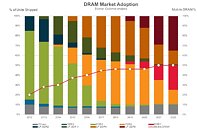Wednesday, October 17th 2018

Cadence, Micron Update on DDR5: Still On Track, 1.36x Performance Increase Over DDR4 at Same Data Rate
DDR5 will be the next step in DDR5 memory tech, again bringing increased transfer speeds over the previous JEDEC (the standards body responsible for the DDR specifications) specification. The new memory technology will also bring the customary reductions in operating voltage - the new version will push the 64-bit link down to 1.1V and burst lengths to 16 bits from 1.2V and 8 bits. In addition, DDR5 lets voltage regulators ride on the memory card rather than the motherboard. CPU vendors are also expected to expand the number of DDR channels on their processors from 12 to 16, which could drive main memory sizes to 128 GB from 64 GB today.
DDR5 is being developed with particular attention to the professional environment, where ever-increasingly gargantuan amounts of addressable memory are required. One of the guiding principles over DDR5's development is a density increase (to allow 16 Gbit chips) that would allow for larger volumes of memory (and thus data processing) in the environments that need that. Reduced power consumption also plays a role here, but all of this will have a cost: latency. For end-users, though, this increased latency will be offset by the usual suspects (DDR memory companies such as Crucial, Corsair, just to name some started with the letter C) in tighter timings and increased operating frequencies. JEDEC's specification for DDR5 is set at 4800 MT/s, but it's expected the memory tech will scale to 6400 MT/s, and you know overclocking and performance-focused companies will walk all over the standard.Some other, performance and stability-centric features of DDR5 include use two independent 32/40-bit channels per module (without/or with ECC); improved command bus efficiency, with per-channel 7-bit Address (Add)/Command (Cmd) buses, better refresh schemes, and an increased bank group for additional performance. There will also be support for on-die termination (a particularly important feature for Ryzen's memory stability and overclocking prowess), which enables cleaner signals with less electrical disruption and feedback, with improved stability at higher data rates. Furthermore, high-end DDR5 DIMMs will have their own voltage regulators and PMICs, thus improving power delivery and other variables.Cadence says that while comparing DDR4 3200 vs DDR5 3200, there is already an increase in bandwidth of 1.36X - yes, at the same data rate. Add in the frequency increase (and consider the density increase as well), and there's a 1.87x increase in performance when comparing DDR4 3200 to DDR5 4800. Ramp for server/datacenter and other professional environments will start in 2019, with the technology entering the consumer market in 2020 - interestingly, the same longevity AMD themselves gave their Zen architecture.
Sources:
Cadence, via AnandTech
DDR5 is being developed with particular attention to the professional environment, where ever-increasingly gargantuan amounts of addressable memory are required. One of the guiding principles over DDR5's development is a density increase (to allow 16 Gbit chips) that would allow for larger volumes of memory (and thus data processing) in the environments that need that. Reduced power consumption also plays a role here, but all of this will have a cost: latency. For end-users, though, this increased latency will be offset by the usual suspects (DDR memory companies such as Crucial, Corsair, just to name some started with the letter C) in tighter timings and increased operating frequencies. JEDEC's specification for DDR5 is set at 4800 MT/s, but it's expected the memory tech will scale to 6400 MT/s, and you know overclocking and performance-focused companies will walk all over the standard.Some other, performance and stability-centric features of DDR5 include use two independent 32/40-bit channels per module (without/or with ECC); improved command bus efficiency, with per-channel 7-bit Address (Add)/Command (Cmd) buses, better refresh schemes, and an increased bank group for additional performance. There will also be support for on-die termination (a particularly important feature for Ryzen's memory stability and overclocking prowess), which enables cleaner signals with less electrical disruption and feedback, with improved stability at higher data rates. Furthermore, high-end DDR5 DIMMs will have their own voltage regulators and PMICs, thus improving power delivery and other variables.Cadence says that while comparing DDR4 3200 vs DDR5 3200, there is already an increase in bandwidth of 1.36X - yes, at the same data rate. Add in the frequency increase (and consider the density increase as well), and there's a 1.87x increase in performance when comparing DDR4 3200 to DDR5 4800. Ramp for server/datacenter and other professional environments will start in 2019, with the technology entering the consumer market in 2020 - interestingly, the same longevity AMD themselves gave their Zen architecture.



32 Comments on Cadence, Micron Update on DDR5: Still On Track, 1.36x Performance Increase Over DDR4 at Same Data Rate
Like when we went from DDR3 2133-2400 MHz at CL9-10 to DDR4 2133-2400 MHz at CL12-14. It was not impressive at all.
Took a long time before we saw high end DDR4 like 3200/CL14 or 3600/CL15
Intel has been pretty much immune to this for ages, however. Their cache does an amazing job hiding memory latency. Sure, if you move more data than it fits in cache, that doesn't work so well anymore, but overall, it's been ages since it made sense for the average Intel user to fork out cash for lower latency.
When chasing high fps (as in 150+) for 144-240 Hz monitors, CPU and memory speed/timings really matters. I'd never choose less than 3200/CL14 here.
For 60ish fps / Hz it's not worth thinking about. You'll be GPU bound anyway.
We're not talking 10-20 fps, but 2-5 fps. It all adds up.
A high clocked (Intel) CPU paired with low latency / high speed memory will deliver the best possible framerates. Nothing new here.
I'm not talking about price to performance here - but best performance.
And especially decent priced!